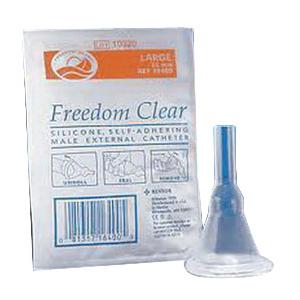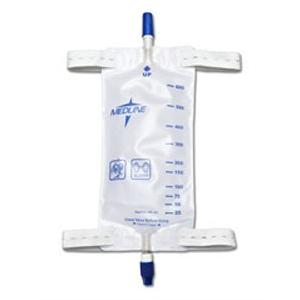When men and women experience leakage from urinary incontinence, urinary retention symptoms, or have prostate problems, their doctor may bring up the use of an intermittent urinary catheter as a solution. For some, using an intermittent or indwelling catheter may not be an option due to frequent catheter-associated urinary tract infections or bladder stones. An external catheter for men and women may be just the right option for managing urinary incontinence.
What are External Catheters?
 Doctors can treat urinary incontinence in men with a male external catheter, which is not like traditional catheters that insert into the bladder to drain urine. Thus, the male external catheter is often referred to as a Texas catheter or condom catheter because it is placed over the penis almost like a condom.
Doctors can treat urinary incontinence in men with a male external catheter, which is not like traditional catheters that insert into the bladder to drain urine. Thus, the male external catheter is often referred to as a Texas catheter or condom catheter because it is placed over the penis almost like a condom.
A female version of an external catheter is also available. We offer the PureWick Female External Catheter. This female external catheter allows for non-invasive urine output management for female patients.
Why an External Catheter May Be Needed?
For men and women that suffer from urinary incontinence, overactive bladder, or mobility issues, an external catheter may be the right choice. The external catheter is designed for those that can drain urine but cannot control when it is released.
Sometimes, an internal catheter is not an option due to frequent urinary tract infections (UTIs) or bladder spasms. External or condom catheters can be beneficial because they are less likely to cause urinary tract infections associated with frequent catheterization. Because male external catheters allow for more movement and are non-invasive, they can be a more comfortable option. Your doctor must size you for the fit to prevent leaks that can lead to skin irritation and breakdown.
Using adult diapers and pads makes the skin susceptible to damage from exposure to urine, but the female external catheter alternative wicks the urine away to keep the skin soft and dry. Female external catheters give females managing urinary incontinence a new and simple option.
How Does an External Catheter Work?
 For men, the difference between a standard condom and a male external catheter or condom catheter is that it has a plug at the end to attach a drainage tube so urine can pass into a collection bag or device that is typically attached to the leg. Unlike the standard condom, most male external catheters, Texas catheters, or condom catheters are self-adhesive.
For men, the difference between a standard condom and a male external catheter or condom catheter is that it has a plug at the end to attach a drainage tube so urine can pass into a collection bag or device that is typically attached to the leg. Unlike the standard condom, most male external catheters, Texas catheters, or condom catheters are self-adhesive.
For women, the external catheter uses a long cylinder with a top layer of absorbent fabric. This cylinder is then placed between the labia and laid against the urethra. The female external catheter uses a low-pressure suction design to pull the urine from the soft, absorbent fabric, through the cylinder, and into a designated container. The female external catheter can be held in place with adhesive pads while being used.
How Long Should an External Catheter Stay in Place?
 External catheters for both men and women should be replaced and disposed of every 24 hours and are not meant to be reused. Remaining clean and sanitary is an essential step when using an external catheter. The chances of getting a UTI or skin infection are increased by leaving an external catheter in place for too long.
External catheters for both men and women should be replaced and disposed of every 24 hours and are not meant to be reused. Remaining clean and sanitary is an essential step when using an external catheter. The chances of getting a UTI or skin infection are increased by leaving an external catheter in place for too long.
When removing an external catheter for men, apply a warm, wet washcloth over the condom catheter to help loosen the adhesive. After slowly rolling down the condom catheter, any leftover residue can be removed using an adhesive remover.
Urinary drainage bags can be reused. The urine collection bag should be emptied when it becomes approximately two-thirds full, and it is recommended to be thoroughly cleaned at least once per day. Cleanse the inside and outside of the bag, as well as the valve, with warm, soapy water. This will ensure to keep it sanitary as it hangs to air dry.
Does Medicare Cover External Catheters?
If you qualify for Medicare, make sure to do some research to ensure that the doctor you choose accepts Medicare. Medicare will not pay a claim for a clinician that is not enrolled. If your clinician is enrolled, Medicare will cover external catheters/urinary collection devices for both men and women who have permanent urinary incontinence and cannot use an indwelling catheter as an alternative.
A detailed list of all the supplies included in Medicare coverage related to external catheters for men and women can be found at the Center for Medicare & Medicaid Services.
External catheters for men and women can be an excellent alternative to indwelling catheters and help prevent catheter-associated urinary tract infections (CAUTI). For questions about any of the male and female external catheters we offer, our Product Experts are just a phone call away and happy to help. If you aren’t finding the external catheter you are looking for; we have access to so many home delivery medical supplies, we are sure to find options for you at a competitive price.





